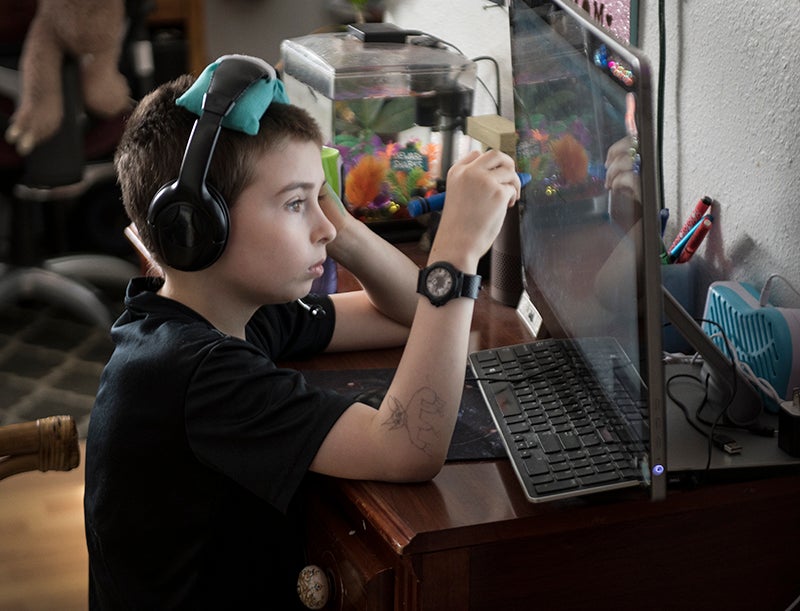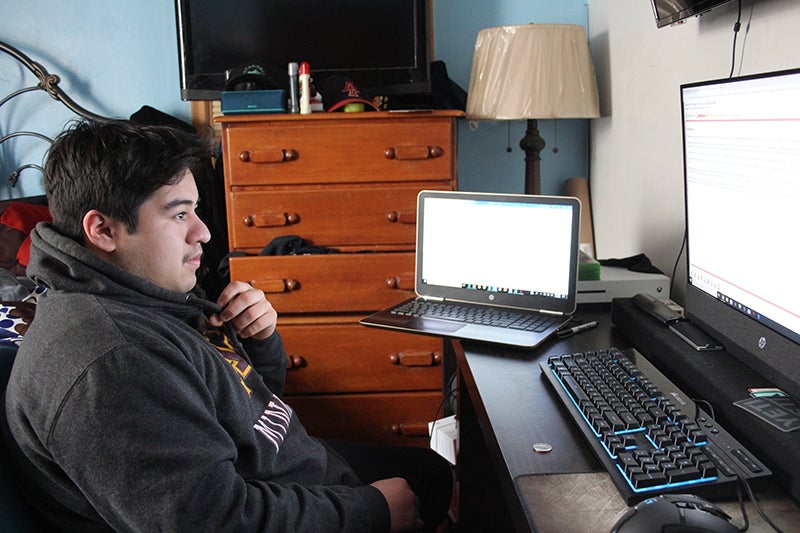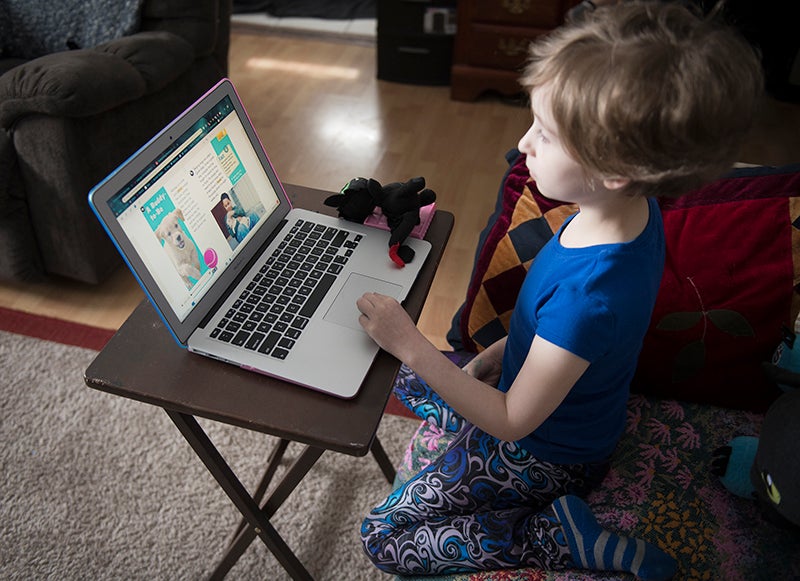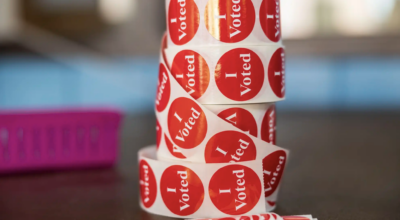Another alternative
Published 7:50 pm Friday, March 8, 2019

- Annara Cottrell works on schoolwork at home last week through Iowa Connections Academy, a free, online K-12 public school. - Colleen Harrison/Albert Lea Tribune
Online schooling another option to help students learn
Sam Cottrell is getting ready to learn. He wakes up in the morning, eats breakfast with his sister, Annara, at the kitchen table, gets ready for the day, has some free time and then walks to school without his shoes on.
He does not need his shoes. To get to school, all he needs are his over-the-ear headphones — padded with a small teal cushion so they fit his 9-year-old-sized head — an internet connection and the chunky blue stylus he uses to write on the desktop computer in his living room.
Both Sam and Annara Cottrell attend Iowa Connections Academy, a free, online K-12 public school. To attend, students open enroll to CAM Community School District located in Anita, Iowa, whose school board governs (but does not employ the staff of) Iowa Connections Academy.
It is one state’s iteration of a nation-wide program, which also has a Minnesota Connections Academy headquartered in St. Paul.
When the school year started, Sam and Annara Cottrell were two of over 600 students enrolled with Iowa Connections Academy, founding Principal James Brauer said. During the seven years Iowa Connections Academy has operated, he said its growth has had its ebbs and flows.
Compared to its sister programs across the country, growth at Iowa Connections Academy has been modest and sustainable, Brauer said.
“We haven’t experienced some of the enrollment explosions other states may have seen,” he said.
Minnesota has.
Minnesota Connections Academy started its first school year in 2004, and for five or six years saw dramatic growth, Principal Melissa Gould said.
“I would say in the last three years, we’ve grown about 200 students each year,” she said.
Though growth has tapered off, Gould said the school is still finding more families looking for an alternative to traditional school.
“I attribute that to us,” Gould said. “You know, we’re obviously doing a job that people are satisfied with. We are a school of choice. No one has to come to our school.”
There are currently approximately 25 Minnesota Connections Academy students enrolled who live in Freeborn County and small portions of Steele, Waseca and Faribault counties, including Ellendale, New Richland and Wells.
Now, that enrollment is focused heavily at the high school level. Of the 2,860 students enrolled in Minnesota Connections Academy, just under half — approximately 1,300, Gould estimated — are high school students.
It was not always this way. Five to six years ago, there were more children at the elementary level, Gould said. Now, she said there are about 500 children enrolled in kindergarten through first grade at Minnesota Connections Academy.
Additionally, enrollment in middle school was also strong.
“Middle school’s kind of a tough time in life … time where peers can be difficult,” Gould said.
Over the last three years, the biggest enrollment trend at Iowa Connections Academy is also a disproportionate number of incoming secondary students, Brauer said.
“I think by and large, high school students, to be honest, just don’t care for the style of school that worked for you and I,” Gould said.

Sam Cottrell works on schoolwork at home last week through Iowa Connections Academy. His mother considered online schooling a better option for him, as Sam lives with Tourette syndrome and autism. – Colleen Harrison/Albert Lea Tribune
Making school work with their schedule
Neither Sam nor Annara Cottrell have attended a traditional — or, rather, a brick-and-mortar — public school for their education.
In 2015, when she was 3, Annara Cottrell was diagnosed with leukemia. With an immunocompromised child in the house, Michelle Cottrell said keeping her daughter away from a building in which germs could be shared and brought home was an added bonus.
But it was not why she signed her up for an online school in the first place.
“I don’t think I would ever be able to put them into public school for different reasons,” she said.
Michelle Cottrell said she and her husband were bullied in school, and she said she watched her sister’s children and her two older children, who went the brick-and-mortar public school route, deal with bullying as well.
“I didn’t want to see my kids go through what I went through,” Michelle Cottrell said.
According to Brauer, Michelle Cottrell is not alone.
“Bullying and harassment absolutely dominated,” Brauer said of enrollments early-on. “That was the reason families wanted to enroll.”
Of the students who enrolled in the first year of Iowa Connections Academy in 2012, he estimated at least a third cited bullying and harassment as a reason for enrollment.
Social-emotional learning and wellbeing continues to be a focal point for Brauer as something along the lines of “social-emotional trauma” is the one of most dominant reasons for why students are enrolling.
“This notion of students with such profound anxiety and depression, students enrolling, let’s say, that identify as transgender, just the stories they’ve had to go through, they have come to us almost out of necessity,” he said.
Brauer said Iowa Connections Academy is on a two- to three-year mission to train staff on providing proper intervention for these students as well as discover resources available for students in their own communities.
“How do we even tackle academics?” Brauer said. “How do we even focus on a student that’s failing social studies? Literally, this id is contemplating whether or not it’s worth living.”
But Michelle Cottrell was also concerned that students with disabilities — students like her son — would not receive the individualized attention or the “right kind of help” because schools may not have the resources to do so, she said. Sam Cottrell has Tourette syndrome, and was very recently diagnosed with autism. For her son, Michelle Cottrell was looking for something with a greater emphasis on individualized learning.
Though Sam Cottrell is in his fourth year of online public school, it is the family’s first year with Iowa Connections Academy. The family originally tried K12, a similar virtual program, but his mother said he was not getting the help he needed to succeed.
Kindergarten was a struggle. Michelle Cottrell said her son missed a lot of kindergarten work because she was supposed to be there, helping him. Instead she was at the hospital with his younger sister.
“Her having cancer affected everyone in the household,” Michelle Cottrell said.
He is repeating second grade at mom’s insistence, Michelle Cottrell said.
But now, he is also adding and subtracting three-digit numbers. She was not sure she would see him do that, Michelle Cottrell said.
“He’s doing so much better,” she said. “I’m so proud of him.”

Enrique Fernandez, a tenth grader with Minnesota Connections Academy, has attended the online public school for 3 years. He said he wanted to explore online school to receive more individualized attention with his education. Sarah Kocher/Albert Lea Tribune
Teachers are a phone call away
There are other reasons students enroll.
“The variety of kids we have is always just mind-boggling,” Gould said.
Some are in theater groups in the Twin Cities, and their days need to include rehearsals. Both Gould and Brauer mentioned Olympics hopefuls with rigorous practice schedules.
“It’s just been really amazing to see that students can actually work toward a diploma and then in their own personal time are handling some of these schedules that an adult couldn’t even successfully muster,” Brauer said.
And at Minnesota Connections Academy, many, like Annara Cottrell, battle significant illness.
For Enrique Fernandez, a 10th-grader living in Albert Lea, Minnesota Connections Academy was a chance to increase individualized attention in the classroom. Aside from a two-year stint in Iowa from 2010 to 2012, Fernandez attended school in Albert Lea through seventh grade.
His mother, Felicia Espinoza, was skeptical of online school. She said she was not sure how the time management would go without a teacher there. But, she said, he could always go back.
He does not think he will.
“I enjoy it,” Fernandez said. He said he likes the more flexible schedule and the accessibility of his teachers.
“My teachers are like a phone call away,” he said.
Fernandez had always had good grades, Espinoza said. They dipped a little when he enrolled with Minnesota Connections Academy, but they turned around right away, she said. Gina Swanson, spokesperson for Minnesota Connections Academy, said a learning curve during the first few months is not uncommon as the family learns to navigate the online environment and the school’s proprietary computer management system, which they may not be used to.
Fernandez works in his room, splitting his work between a laptop computer, with notes and a digital textbook, and a desktop monitor, with a slideshow that walks him through a science lesson on Pathogens. Fernandez said he spends between six and seven and a half hours a day working on school.
While Fernandez walks himself through the lessons, it is not the same as homeschooling, Espinoza said. The online public schools employ teachers, who record lessons and give live lessons through screen-sharing.
As a secondary student, Fernandez’s work is more independent than that of an elementary student. According to Gould, secondary students still have instruction in virtual classes, but it is not necessarily webcam-to-webcam teaching. Much of the time, lessons are done through voiceover.
“So, it’s much like a traditional classroom, only you can’t see the teacher,” Gould said.
For younger students, the school day involves more involvement from the parent, or “learning coach.”
Gould called it “shoulder to shoulder” work, where the parents sit with and guide students to the virtual classroom or help them find lessons, though not teaching or giving instruction. She said a parent is required to be at home with any student between kindergarten and fifth grade.
All grade levels do one-on-one conferencing over the phone, Gould said.
“I honestly think it’s been going well,” Espinoza said.
She said she is considering sending her daughter, currently in fifth grade in Albert Lea, to Minnesota Connections Academy. Espinoza, like other parents Gould mentioned, is wary of middle school social dynamics.
In addition to school, Iowa Connections Academy and Minnesota Connections Academy both offer extracurriculars. Though Fernandez is not involved in any, Espinoza said she would like him to be, so he can meet new students his age.
In Minnesota, students can participate in musical madness club, gay-straight alliance, Dungeons and Dragons club and a cat club, to name a few. And while the Iowa Connections Academy also offers online clubs and activities, the Iowa legislature recently afforded them the opportunity for their students to do something they had not been able to do before: school sports.
Now, Brauer said, the legislature allows students to enroll in two activities, either sports or clubs, in their home school districts. He has had conversations with students who were interested — generally in music — but who did not consider online school viable because they wanted to participate in these activities.
“Boy, the number of kids that want to do FFA,” he said.
Brauer said he could not figure out how to offer it online. He tried.
“If we’re truly going to provide for students what they need and what they want, here’s an opportunity now where a student really can pursue schooling online full-time” but can continue activities in their resident district, Brauer said. “… Everybody wins in this.”

A computer reads Annara Cottrell a book about seeing eye dogs and highlights the words so she can follow along. – Colleen Harrison/Albert Lea Tribune
Traditional doesn’t meet every student’s needs
Before starting with Iowa Connections Academy, Brauer was working in an alternative school for students with special needs in a north Kansas City school district.
“I never saw my career going this route,” he said. “I can definitely admit to that.”
But after six or eight years in the field, he saw the need for a nontraditional route for students.
“I say this with respect, but the traditional model, it just doesn’t meet the needs for every student, and as soon as we can admit to that and we don’t just necessarily try to protect that traditional model just for the sake of ‘This is the way it’s always been’ … you have to meet the kid where the kid is.”
That is when Brauer said he realized online school was an “up and coming” part of education. Then, he saw the posting.
“This is literally everything I kind of advocate for in the field of education as another option,” he said.
As a former assistant principal in a brick-and-mortar school, Brauer knows his work as principal at Iowa Connections Academy is “very different.”
The biggest advantage? Leaving some of the brick-and-mortar time constraints — hallway supervision, lunch duty, bus supervision, after-school supervision — behind and focusing that on student learning, Brauer said.
He said much of his role includes tracking data and working with student performance. Iowa Connections Academy uses tools to monitor a student’s on-track performance based on how many lessons they’ve completed per day — typical is six to eight — and how much time they’ve spent on lessons.
Like a brick-and-mortar Iowa school, the district is required by the state to provide a minimum of 1,080 hours of instructional time.
Funding comes through the same process as open enrollment: as students transfer to the district, their state funds transfer to the district, as well, Gould and Brauer said.
While Brauer said Iowa Connections Academy has the same compulsory educational requirements by law as a traditional school, Gould said Minnesota is a bit stricter on online schools.
“There’s a lot more oversight than there is with a traditional school,” she said.
At the end of each school year, Minnesota Connections Academy submits a comprehensive report to the state with pass rates for all its courses. Any classes the school wants to add or change has to be approved. Every three years, online schools go through an extensive review process “where every nook and cranny of our system is looked at” to provide evidence the school is meeting state standards.
“They just want the oversight because even though online has been around for 15 years, it’s still relatively new,” Gould said.
‘A great kind of safety net’
Most students stay online with Minnesota Connections Academy for two to three years, Gould said. They leave for many reasons.
Some come in knowing they will not stay, like middle schoolers who then move on to a brick-and-mortar high schools.
“It’s a great kind of safety net for students to go online,” Gould said, for them to rebuild self-esteem.
Some may decide to graduate with their in-town classmates. And for some students, they may just need more structure.
“We never pressure kids to stay, as much as we want them to,” Gould said.
But the turnover causes challenges at both the Minnesota and Iowa schools, Gould and Brauer said. According to Gould, every year their enrollment is 50 percent new students. Brauer estimated about 30 percent of students are newly enrolled yearly.
“We really do encounter a whole new cadre of students … every single year, which makes continuity (tough) in terms of building relationships from one grade to the next,” he said.
Additionally, both schools are challenged by students who enroll who are behind in school to earn enough credits to graduate.
“That was not something our staff was prepared for,” Brauer said.
Gould said approximately 65 percent of their high school students who enroll come with significant credit deficiencies. This can be tough on the graduation rate.

Sam Cottrell poses for a picture with one of his dragons that help him focus on his schoolwork. – Colleen Harrison/Albert Lea Tribune
‘It’s another option’
At home with his headphones on, Sam Cottrell draws on his desktop with his chunky blue stylus. He’s working on a three-digit math problem: 352 + 75. He talks to himself. The air filter on a fish tank burbles along.
On the couch a few feet away, Annara Cottrell sits, surrounded by stuffed dragons and one cat, reminiscent from her vast collection gifted to her while undergoing leukemia treatment. She is in remission now, though they cannot officially say that until August 2020, five years after her diagnosis, Michelle Cottrell said. In the meantime, she still goes to doctor appointments and the pool for physical therapy. Now, the computer reads to her a book about seeing eye dogs and highlights the words so she can follow along like karaoke.
Brauer said he does not see the online model replacing traditional brick-and-mortar schools. He also said he knows every child is not made to learn online. But for him, it aligns with what he stands for professionally in how to meet students’ needs.
“It’s not a perfect model,” Brauer said. “And I’ll never defend online schools just for the sake of saying ‘It’s online schools’ … but it’s another option. It’s an option for students that they truly, genuinely need another opportunity.”
Someday, Sam and Annara Cottrell might go to a brick-and-mortar school, Michelle Cottrell said. For the lower grades, she wants to keep them at home. Later, if they choose to be in “regular” public school, they will give it a shot, she said.
But for now, it is indoor recess. Annara and Sam Cottrell are off to do jedi training, and to protect the dragon eggs from nest raiders.






